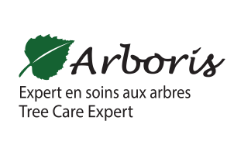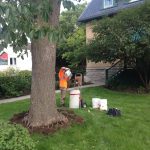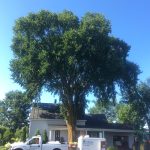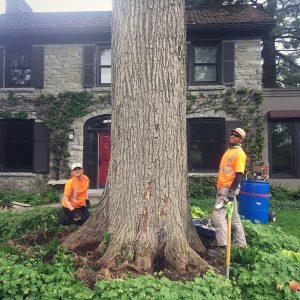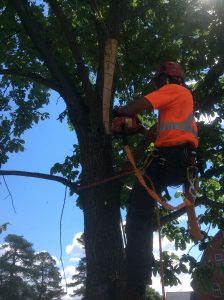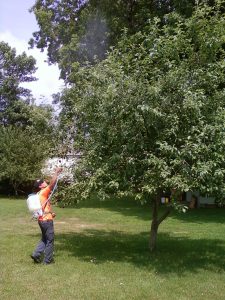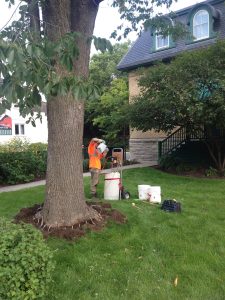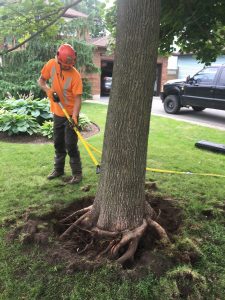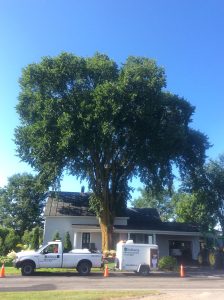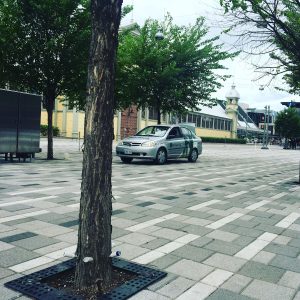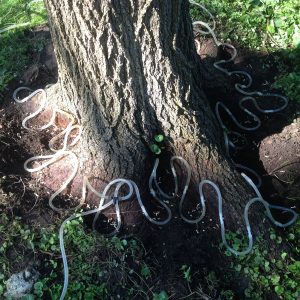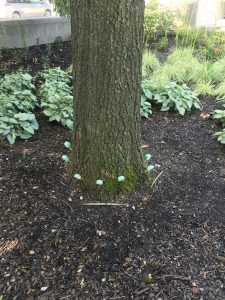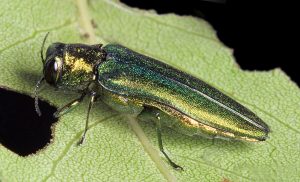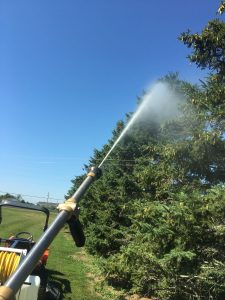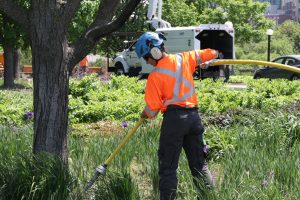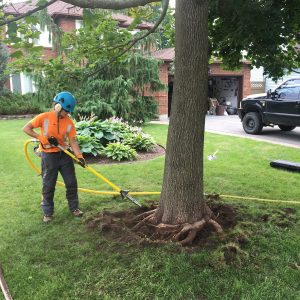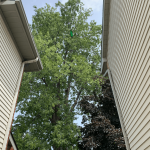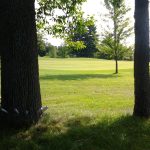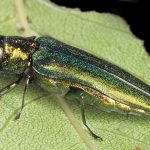common tree diseases
DUTCH ELM DISEASE (DED)
Dutch elm disease is a fatal disease caused by the fungus, Ophiostoma novo-ulmi. This fungus grows only in trees of the genus ulmus and is responsible for the death of millions of elms.
The Ophiostoma novo-ulmi fungus originated in Asia and was imported to Europe, where Dutch researchers were the first to isolate it (hence the name Dutch elm disease). It was later imported to the United States where it spread throughout the native elm range, and is now widely distributed in Canada.
Symptoms of elm disease include:
- Dead spots on leaves that spread and cause early leaf drop
- Progressive dieback of the tree, with dead branches and reduced growth
- Cracking of the tree’s bark
Elm disease has had a significant impact on elm populations in Europe and North America, where it has caused the death of millions of trees. Trees affected by the disease are often difficult to save and must be felled to prevent the spread of the disease.
Preventive measures, such as using disease-resistant elm varieties, treating trees before they are affected, and controlling insects that carry the disease, can help limit the spread of elm disease.
EXPERTS IN DED MANAGEMENT
Our team has many years of experience in the control of Dutch Elm Disease. Arboris has treated thousands of elm trees from the Ottawa area to Quebec City. Over the years, we have become the benchmark in DED management.
DETECTING FOR DED
Here are some of the signs to look for in detecting Dutch elm disease:
Leaf discoloration and wilting
Dutch elm disease can cause discoloration and wilting of the tree's leaves, which can then spread to other parts of the tree.
Premature leaf loss
Trees with the disease may lose their leaves prematurely, well before the normal fall season.
Cracked bark
The bark of the tree may begin to crack or peel, revealing dead or necrotic areas underneath.
Branch loss
Trees with the disease may lose significant branches from their structure.
Crown reduction
Trees with the disease may show signs of crown shrinkage, with branches and leaves no longer growing normally.
TREATMENT OF DED
Unfortunately, there is currently no cure for Dutch elm disease, but it is possible to slow the progression of the disease and extend the life of the tree by using preventive treatment methods. Here are some of the possible treatment methods:
Application of insecticides
Insecticides can be applied to the tree to kill disease-carrying insects, such as elm bark beetles. This can help prevent the spread of the disease.
Fungicide injection
Fungicides can be injected into the tree to prevent infection of the disease. However, this will not cure the tree and can only slow the progression of the disease if the elm is already infected.
At Arboris, we use Arbotect® 20-S, a systemic fungicide formulated with thiabendazole and applied with a process called Macro-infusion. Arbotect 20-S is the only scientifically proven fungicide that provides multi-year protection against Dutch elm disease. Arbotect ® 20-S is now available in Canada.
Create a trench
The only way to stop the spread of Dutch elm disease through root grafts is to physically sever the root connections between the infected and healthy tree. This is most often done with compact trenchers or excavators. In situations where there are buried utilities, an air spade can be used to remove the soil and expose the root grafts without damaging the utility lines.
Pruning of Infected Areas
Pruning infected parts of the tree can help slow the spread of the disease.
Planting resistant elm trees
Elm varieties resistant to Dutch elm disease can be planted. This can help prevent the spread of the disease in areas where trees have been cut down due to the disease.
EMERALD ASH BORER
The emerald ash borer (EAB) is a metallic green borer beetle about 1 to 1.5 cm long that attacks all native ash species, usually killing them in two to three years. Its larvae tunnel under the bark to feed on the inner bark tissue. The tunnels cut off the flow of nutrients and water to the leaves, and cause the tree to die. Native to China, this invasive species was discovered in Windsor, Ontario in 2002. Since then, the pest has spread to many parts of Ontario and Quebec and 15 states in the United States.
The EAB attacks ash trees by laying eggs in cracks in the bark of the tree. The larvae that hatch from these eggs feed on the tissue under the bark, disrupting the flow of sap to the tree and causing the tree to die. Signs of an EAB infestation include oval exit holes in the bark, a decline in the health of the tree, dead branches, and increased growth on the tree trunk.
EAB can spread rapidly and cause significant damage to ash tree populations. It is important to detect and treat infestations as soon as possible to prevent the spread of the insect.
EMERALD ASH BORER DETECTION
Signs that your ash tree is affected by EAB include:
Leaves begin to die
The tree's leaves may yellow, wilt and fall prematurely, often starting in the upper part of the tree.
The upper branches of the tree die
The upper branches of the tree may begin to die, with dry twigs and bare branches.
Oval holes in the bark
EAB leaves oval holes in the bark of the tree, which may be visible to the naked eye.
Galleries under the bark
Pruning infected parts of the tree can help slow the spread of the disease.
Shoots along the trunk
Shoots along the trunk of the tree, also known as suckers, may appear at the base of the tree.
Bark deformation
Bark may crack or warp, especially on the branches of the tree.
If you see any of these signs, it is important to call a professional arborist to confirm if your tree is infested with EAB. The earlier the infestation is detected, the easier it will be to treat and prevent the spread of the insect.
EAB TREATMENTS
There are several possible treatments to control EAB, including:
Use of insecticides
Insecticides can be applied to the tree to kill EAB larvae. Insecticides can be applied directly to the tree as a spray or injection.
At Arboris, we prioritize TreeAzin insecticide which is an injectable azadirachtin insecticide extracted from neem seeds. It is not a neem oil product. In Canada, TreeAzin is registered by Health Canada's Pest Management Regulatory Agency (PMRA) (PCP 30559). The Ontario Ministry of the Environment (MOE) has classified TreeAzin as a Class C, with an active ingredient that is part of the « List of Active Ingredients Authorized for Cosmetic Uses (Allowable List) ». TreeAzin is exempt from the Ontario Cosmetic Pesticides Ban Act, 2008. The TreeAzin solution is injected into the trunk and spreads rapidly through the tree's vascular system. The EAB larvae ingest the product and stop their development, eventually killing them. In addition, when adult females feed on the leaves, they become sterile.
Pruning of branches
Pruning infected branches can help eliminate areas of infestation and prevent the spread of the insect.
Trapping
Traps can be used to attract and capture EAB adults. This can help reduce the insect population and limit their ability to lay eggs.
At Arboris, we use the FraxiProtecTM product. This system was designed as a self-contamination device, which includes a Lindgren trap and a contamination chamber containing a pouch coated with a fungus that acts as an active ingredient. The active ingredient in FraxiProtec is the CFL-A isolate of the fungus Beauveria bassiana, which has been proven effective against EAB in numerous laboratory and field trials. The fungus is also safe for other insects, as the active ingredient is concealed in a contamination chamber rather than being sprayed into the environment.
Tree Removal
In severe cases where the tree is severely infected, felling may be necessary to prevent the spread of the insect to other trees.
